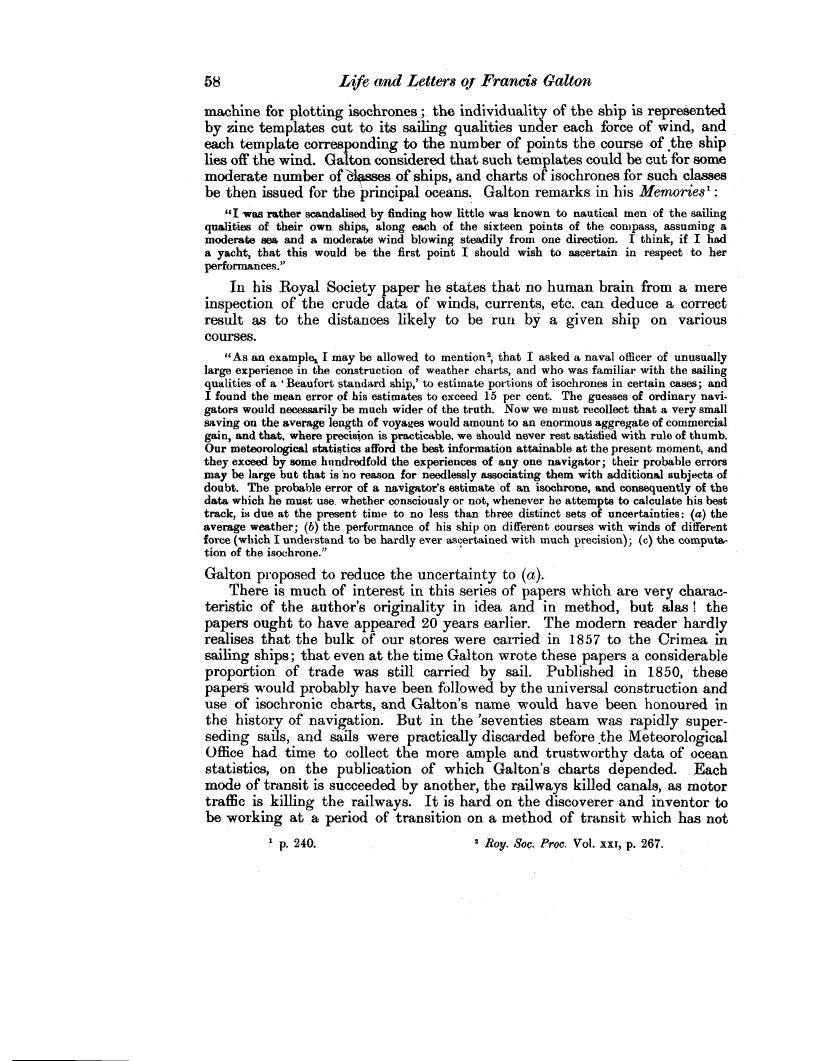58 Life and Letters o, j Francis Galton
machine for plotting isochrones ; the individuality of the ship is represented by zinc templates cut to its sailing qualities under each force of wind, and each template corresponding to the number of points the course of the ship lies off the wind. Galton considered that such templates could be cut for some moderate number of ciasses of ships, and charts of isochrones for such classes be then issued for the principal oceans. Galton remarks in his Memories'
"I was rather scandalised by finding how little was known to nautical men of the sailing qualities of their own ships, along each of the sixteen points of the compass, assuming a moderate sea and a moderate wind blowing steadily from one direction. I think, if I had a yacht, that this would be the first point I should wish to ascertain in respect to her performances."
In his Royal Society paper he states that no human brain from a mere inspection of the crude data of winds, currents, etc. can deduce a correct result as to the distances likely to be run by a given ship on various courses.
"As an example,, I may be allowed to mention', that I asked a naval officer of unusually large experience in the construction of weather charts, and who was familiar with the sailing qualities of a ' Beaufort standard ship,' to estimate portions of isochrones in certain cases; and
I found the mean error of his estimates to exceed 15 per cent. The guesses of ordinary navigators would necessarily be much wider of the truth. Now we must recollect that a very small saving on the average length of voyages would amount to an enormous aggregate of commercial gain, and that, where precision is practicable, we should never rest satisfied with rule of thumb. Our meteorological statistics afford the best information attainable at the present moment, and they exceed by some hundredfold the experiences of any one navigator; their probable errors may be large but that is 'no reason for needlessly associating them with additional subjects of doubt. The probable error of a navigator's estimate of an isochrone, and consequently of the data which he must use. whether consciously or not, whenever he attempts to calculate his best track, is due at the present time to no less than three distinct sets of uncertainties: (a) the average weather; (b) the performance of his ship on different courses with winds of different force (which I understand to be hardly ever ascertained with much precision); (c) the computa
tion of the isochrone."
Galton proposed to reduce the uncertainty to (a).
There is much of interest in this series of papers which are very characteristic of the author's originality in idea and in method, but alas ! the papers ought to have appeared 20 years earlier. The modern reader hardly realises that the bulk of our stores were carried in 1857 to the Crimea in sailing ships; that even at the time Galton wrote these papers a considerable proportion of trade was still carried by sail. Published in 1850, these papers would probably have been followed by the universal construction and use of isochronic charts, and Galton's name would have been honoured in the history of navigation. But in the 'seventies steam was rapidly superseding sails, and sails were practically discarded before the Meteorological Office had time to collect the more ample and trustworthy data of ocean statistics, on the publication of which Galton's charts depended. Each mode of transit is succeeded by another, the railways killed canals, as motor traffic is killing the railways. It is hard on the discoverer and inventor to be working at a period of transition on a method of transit which has not
1 p. 240. 2 Roy. Soc. Proc. Vol. xxi, p. 267.

